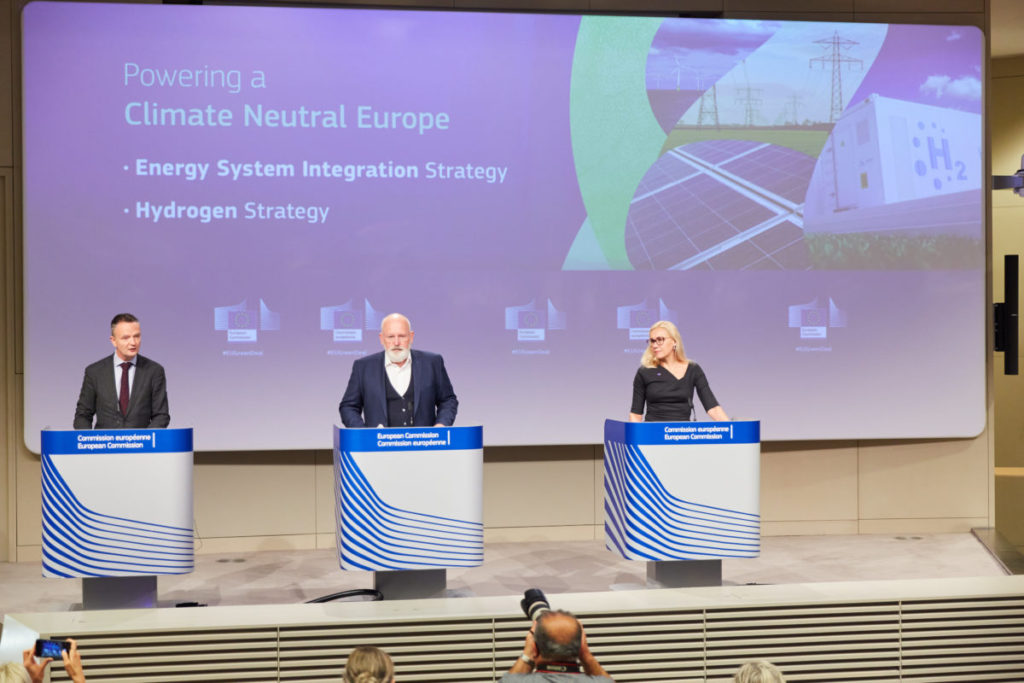EU hydrogen strategy could drive 120 GW of renewables capacity

The European Commission has outlined a long-anticipated plan it says could unlock up to €340 billion for new solar and wind projects over the next decade. The 30-year strategy envisages up to €470 billion being spent on electrolyzer capacity.

The EU’s hydrogen and energy system integration strategies will set a new clean investment agenda for the bloc, the European Commission has announced.
“With 75% of the EU’s greenhouse gas emissions coming from energy, we need a paradigm shift to reach our 2030 and 2050 targets,” said commissioner for energy Kadri Simson at the launch of both documents yesterday. “The EU’s energy system has to become better integrated, more flexible and able to accommodate the cleanest and most cost-effective solutions. Hydrogen will play a key role in this as falling renewable energy prices and continuous innovation make it a viable solution for a climate-neutral economy.”
Under the terms of the hydrogen plan, the preference is for a clean energy version of the fuel – generated by renewables-powered electrolysis – rather than creating it by separating carbon from natural gas.
The strategy requires EU legislative bodies to ensure hydrogen policy is anchored in the bloc’s climate and energy laws; that a uniform taxonomy and terminology be used; and that common certification and standards, based on life-cycle carbon emissions, are applied.
The commission pledged to ensure clean hydrogen is included in all green investment and recovery instruments the EU has to offer. However, the strategy admitted some ‘blue hydrogen’ – generated from natural gas and with emissions offset by carbon capture, reuse, and storage – would be necessary to establish an initial market.
EU policymakers will hope the spending and generation capacity figures announced yesterday will soothe fears a role for blue hydrogen will enable gas majors to continue supplying the fossil fuel into the energy system.
The Plan
In its first four years alone, the strategy envisions the deployment of around 6 GW of new electrolyzer capacity to produce a million tons of green hydrogen. That figure would be ramped up to 40 GW of electrolyzer capacity and ten million tons of hydrogen from 2025-30. From 2030 on, the strategy anticipates green hydrogen would be a mature technology to be used in ‘hard-to-decarbonize’ sectors.
European funding pots, including the Next Generation EU Covid-19 recovery plan and the European Investment Bank, would have to stump up some of the substantial investment required to kick-start the hydrogen economy at a sufficient pace. The Next Generation EU fund, for example, has doubled the budget of the bloc’s InvestEU private-sector-facing organization.
Other sources of funding include the European Regional Development Fund; the Cohesion Fund – which channels investment to member states where gross national income is less than 90% of the bloc average; the Covid-recovery-focused REACT-EU instrument established to further cohesion aims; and the Just Transition Fund set up to help fossil fuel-dependent regions transition to clean energy. Staff at such EU bodies would work with member state national and regional authorities to roll out hydrogen projects and enable knowledge transfer and public-private partnerships. Policymakers would apply the regulation required to establish sufficient certainty to attract private-sector investors and to adapt infrastructure and logistics networks to enable hydrogen consumption.
The European Clean Hydrogen Alliance launched by the commission yesterday – featuring industry leaders, civil society, policy makers and the European Investment Bank – will be tasked with building a hydrogen investment pipeline and demand for the energy source. Internal market commissioner Thierry Breton said: “It will develop a pipeline of concrete projects to support the decarbonization efforts of European energy-intensive industries such as steel and chemicals. The alliance is strategically important for our Green Deal ambitions and the resilience of our industry.”
With every stage of the hydrogen value chain represented – production, transmission, mobility, industry, energy and heating – the commission said the alliance could advise on the necessary labor market adjustments and skills required for hydrogen adoption and the organization would also use sector-specific chief executive roundtable events to determine critical projects and coordinate investment.
The bill
With 1.5-2.3 GW of EU green hydrogen production capacity already announced and 22 GW of electrolyzers at an early stage of development, the commission anticipated €24-42 billion would be needed for electrolyzer capacity up to 2030, with a total production cost bill to mid-century of €180-470 billion. Electrolyzers, in turn, will require €220-340 billion for the commissioning of 80-120 GW of solar and wind generation capacity over the next decade. That will cheer renewables proponents more than the estimated €11 billion required to retrofit blue hydrogen facilities with carbon capture and storage systems over the same period.
Distributing hydrogen from production centers to end users will require a further €65 billion, according to the commission, although it was not clear over what period that expenditure would be required. A further sum of almost €1 billion would be needed to deploy 400 small hydrogen refuelling stations.
Creating demand could be expected to carry a hefty price tag too, with the average European steel factory requiring €160-200 million to convert to hydrogen use.
“The strategies adopted today will bolster the European Green Deal and the green recovery and put us firmly on the path of decarbonizing our economy by 2050,” said Frans Timmermans, executive VP of the commission, yesterday. “The new hydrogen economy can be a growth engine to help overcome the economic damage caused by Covid-19. In developing and deploying a clean hydrogen value chain, Europe will become a global front runner and retain its leadership in clean tech.”

